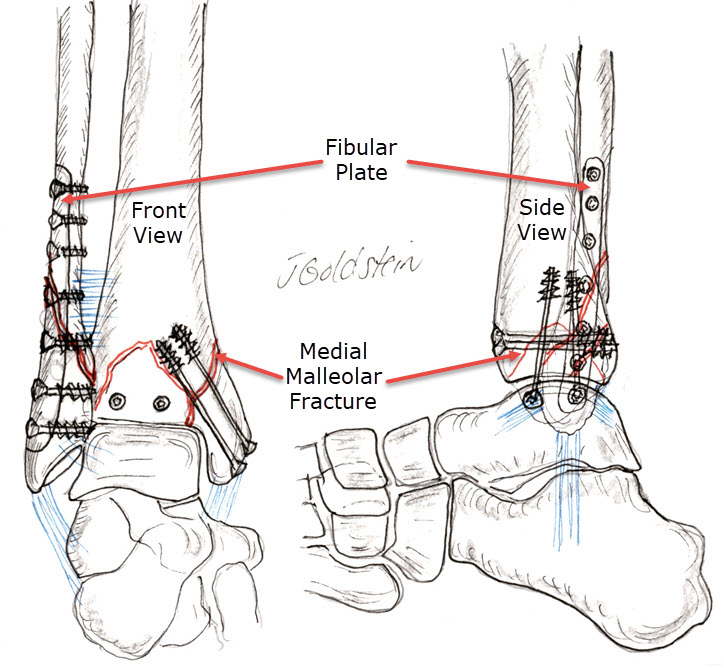Ankle fracture and treatment 
Ankle fractures are common injuries which occur in all ages. Fracture treatment is dictated by the fracture geometry and severity. This correlates highly with the mechanism of injury. Many ankle fractures occur with simple twisting injuries, loss of footing when going downstairs, sports injuries or more high-level trauma in motor vehicle accidents or falls from a height. These fractures as other fractures are more prevalent in situations of osteoporosis or with other underlying causes of bone weakness. Many of these fractures occur in normal bone only secondary to the mechanism of injury.
Symptoms:
Symptoms are generally obvious with an ability to ambulate. Minor ankle fractures can occur with low-grade trauma and result in pain without deformity. With severe fractures, the obvious deformity is evident with instability at the ankle fracture site. Moderate to severe swelling is common with complex ankle fractures. This should be treated with rapid splinting, ice and elevation without weight-bearing. Severe fractures are often either best treated rapidly before swelling occurs or following a week of reduction in swelling with appropriate splinting in place to immobilize the fracture and aid swelling reduction.
Fracture treatment:
Orthopedic Treatment, as in all fractures is dependent on fracture geometry and severity. Ankle fractures are often described as medial malleolar, lateral malleolar, bimalleolar or trimalleolar. Because of the connection between fracture geometry and mechanism of injury, they are often described by the mechanism itself such as inversion and internal rotation. A simple isolated fibular fracture or lateral malleolar fracture, if minimally displaced and below the level of the ligaments between the fibula and tibia may be treated with simple walking boot immobilization and rapid mobilization with partial weight-bearing. This requires x-ray evaluation at intervals to assure that no displacement occurs. This is unlikely if the deltoid or medial ankle ligament is uninjured. Medial malleolar fractures generally require operative fixation and if associated with lateral malleolar or fibular fractures, nearly always are best treated operatively. Fracture fixation and internal fixation, in general, allows for rapid mobilization and immediate weight-bearing and improve function with less downtime. A trimalleolar ankle fracture is a combination of medial malleolar fracture, fibular fracture, and posterior tibial fracture. Ankle fractures can also combine high fibular fractures with medial malleolar fractures and involve disruption of the ligaments between the tibia and fibula. This may allow translation of the foot relative to the tibia which if left unrepaired can accelerate arthritis of the ankle quickly. Tibial Pilon fractures are problematic in that they disrupt a good portion of the distal tibial articular surface with the talus or ankle joint with a compression injury. Pilon means “hammer blow” in French. These fractures require careful reconstruction and sometimes the addition of bone grafting to maintain a joint surface in its anatomic position along with minimal weight-bearing for a month following surgery.
Fracture fixation is generally accomplished with screw fixation of medial malleolar fractures and thin semi-tubular plate fixation of lateral malleolar or fibular fracture.
Surgery:
Surgical intervention as noted previously is best performed either rapidly before severe swelling occurs or following a week of immobilization in a splint allowing swelling to reduce. This is important because severe swelling following surgery may increase the risk of infection and other complications. Fracture fixation in anatomic position minimizes the risk of late arthritis while usually improving motion and function more rapidly than simple cast immobilization. This is the case because solid internal fixation allows for motion of the ankle and less perioperative stiffness. In addition, the use of joints, in general, improves the rate of bone healing actually improving the healing process. Fracture fixation method and treatment depends on multiple factors including patient, age, and level of activity prior to the injury. These decisions are based on multiple personal factors as well as the fracture anatomy displacement and level of instability.
Complications:
In most cases, ankle fractures do very well. Many ankle fractures are treated as an outpatient requiring no hospitalization with immediate ambulation and partial weight-bearing. A small risk of infection is always present with surgical intervention and late osteoarthritis is possible despite perfect fracture fixation owing to the disruption of the joint surfaces with the fracture itself.
Rehabilitation:
Most patients can be treated as an outpatient and return home immediately with at least partial weight-bearing. It is unusual for patients to require temporary nursing home placement however in an elderly individual with little support at home and inability to ambulate safely, this may be necessary.
Summary:
Ankle fractures are common injuries and seen in all ages with multiple causes. Metabolic factors may impact the risk of ankle fracture as well as the stability of fixation and the treatment choices. Most ankle fractures can be treated as an outpatient and with early surgical fixation nearly always allow a rapid return of function.
Compliments of Sports Medicine and Orthopaedics, East Providence Rhode Island
